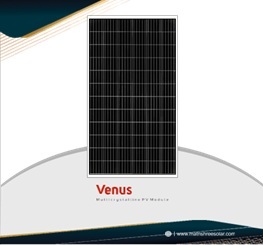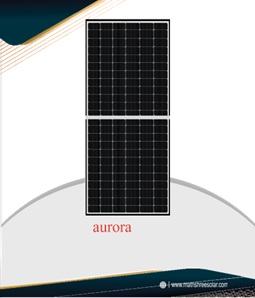Ideal for urban homes, businesses, and institutions, our on-grid solar systems connect directly to your electricity grid.
How It Works:
- Generates electricity during the day
- Excess power is sent to the grid
- Procurement and project management.
- Imports power from the grid at night
- Net metering helps offset your electricity bill
System Features:
- High-efficiency Monocrystalline or Polycrystalline Panels
- Smart Inverters with Wi-Fi Monitoring
- Procurement and project management.
- Bi-Directional Net Metering
- Easy Maintenance & Installation
Types of Solar Panels We Offer
Monocrystalline Panels – Venus Series
- High efficiency (18–24%)
- Sleek black design
- Great for limited space
Key Features:
- Efficiency: Monocrystalline solar panels have high efficiency levels, typically ranging from 15% to 22%, with some panels reaching up to 21.13% efficiency.
- Durability: These panels are known for their robust durability and long lifespan, lasting well over 25 years with proper maintenance.
- Aesthetics: Monocrystalline panels have a sleek, black appearance that seamlessly integrates with various architectural styles.

Mono PERC Half-Cut Panels- Aurora Series
- Combines three advanced technologies
- Excellent in shaded or high-temperature areas
- Higher power output and durability
Key Features:
- Higher Efficiency: Half-cut cells can boost panel efficiencies by a few percentage points, resulting in more electricity generated per square foot.
- Improved Shade Tolerance: These panels are more resistant to shading, as the unique wiring arrangement allows them to tolerate more shadow without compromising the entire panel's performance.
- Reduced Resistive Losses: By cutting solar cells in half, the current generated by each cell is reduced, resulting in fewer resistive losses when energy passes through cells and wires.
- Increased Power Output: By cutting solar cells in half, the current generated by each cell is reduced, resulting in fewer resistive losses when energy passes through cells and wires.
- Less Severe Hot Spots: The consequences of hot spots on these panels are less severe due to the increased number of cells, which can distribute surplus heat more efficiently.
- Better Durability: Half-cut cells are more physically robust and less prone to breaking due to their smaller size, resulting in lower mechanical stresses.
- Enhanced Module Output: These panels can enhance module output by up to 15 watts, with efficiencies reaching up to 19.79%.
Some notable specifications of mono PERC half-cut panels include:
- Number of Cells: Typically 120 or 144 half-cut cells per panel, compared to 60 or 72 cells in traditional panels.
- PERC Technology: Passivated Emitter and Rear Cell technology provides improved module efficiency.
- Panel Design: The panel is divided in half, allowing the top and bottom halves to act as two independent panels, producing electricity even if one half is shaded.

Bifacial Panels- Aurora Series
- Capture sunlight on both sides
- 5–30% higher yield with reflective surfaces
- Ideal for carports, concrete roofs, and high-reflectivity areas
Key Features:
- Increased Energy Yield: Bifacial panels can generate electricity from both the front and back sides of the panel, resulting in a potential increase in energy yield of up to 25%.
- - Improved Performance in Low-Light Conditions: Bifacial panels can capture reflected light from the surrounding environment, making them suitable for installations with high albedo (reflectivity).
- - Durability and Longevity: Bifacial panels are designed to withstand harsh environmental conditions and have a long lifespan, typically 25 years or more.
- Versatility: Bifacial panels can be used in a variety of applications, including ground-mounted systems, rooftop installations, and building-integrated photovoltaics (BIPV).
Some notable specifications of bifacial solar panels include: